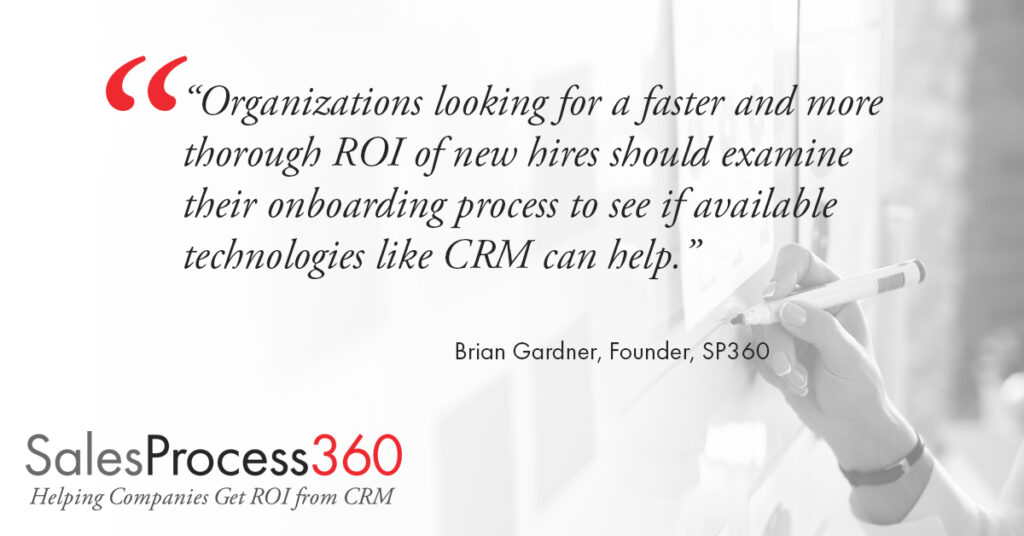Onboarding is a challenge for most technical companies. In my 30-plus years as a hiring manager in the industrial automation business it took, on average, three months to learn the product and application basics. Even with three to five years’ experience, it took six months to become proficient enough to make effective sales calls. Despite this lag in performance, many companies have no effective policy or procedure that ensures efficient and effective onboarding.
Consider, if you pay a base salary of $125,000 plus another 20% for benefits, etc. and you can onboard in three vs. six months you save $37,500. Many times, I have seen the hiring manager cobble together a last-minute, 30-60-90 day assimilation plan.
Totally ineffective.
Why is it important? The Brandon Hall Group reports that effective onboarding will increase retention by 82%. Bamboo HR says if you have a good program, employees are 18X more committed to the company, but Gallup says only 12% of companies deliver a good onboarding experience. Let’s look at the industrial marketplace and what makes onboarding so challenging.
Industry Knowledge, Application & Language: Technical salespeople need to have a deep understanding of the industries they serve. They need to learn applications, specific terminology, regulations and challenges. The pulp and paper business, for example, speaks a language that is different from oil and gas. Onboarding programs need to equip salespeople with the skills to effectively communicate technical information and the overall value proposition to clients in a way that is understandable and persuasive. Nothing is more important to the buyer/ seller relationship.
New Tech: Technology moves fast. Technical salespeople must stay updated on the latest developments. Onboarding programs need to emphasize continuous learning. They also need a platform to share information with team members.
The Who – Team Communication: Technical salespeople often need to collaborate closely with account stakeholders from crossfunctional support teams. The Who are the stakeholders. Salespeople cover different locations of the same account, regionally, globally, engineering and product development teams. Together they bridge the gap between sales and technical teams.
Account History: Account history includes buying behavior, portfolio potential, possible pull through, solutions by application, sales forecast, etc. How do we leverage the collective knowledge of the organization to build a content-rich customer environment that is updated and organized? It’s easily accessed and grows as demand changes.
Value Prop: Perhaps nothing is more important than teaching salespeople how to effectively communicate the value of their products or services to all account buying influences: economic, technical and the user. An effective value proposition discussion is all about the right people, contributing the right level of communications, through meaningful conversation. This requires a lot of coordination and effective communication.
CRM to the rescue! CRM is designed to manage and analyze interactions throughout the customer lifecycle. As an enabling technology, CRM can educate new hires on specifics like customers, regions, product preference, competition, etc. “CRM can be a core technology that hosts, connects and analyzes all the necessary elements of the onboarding plan in a rich business intelligence hub, creating a data repository guiding new hires through the Onboarding process,” Gardner says. And the beauty of the technology is it is likely already there. You just need to turn on the power of the technology and account for the need during the Project Design phase.
If this is not your strength, consider a CRM implementation expert to guide this process. “It helps to have someone who is experienced in your CRM technology, and the industrial sales process,” says Roger Abrahams of OTC, a distributor. “SP360 knows process, people and platforms…they have deep experience in the industrial marketplace.”
Centralized Employee Information – A CRM system can serve as a centralized repository for employee information, including contact details, role, department, and other relevant data. This makes it easy for requests to be quickly routed to the right individual, improving the customer service experience. Perhaps even before anyone in a remote office has even heard the name of the new hire.
Automated Onboarding Workflows: CRMs often have workflow automation capabilities. You can design workflows that automate certain onboarding processes, such as sending welcome emails or assigning certain training modules. Many CRM platforms offer integration capabilities, allowing them to connect with other tools used in the onboarding process, such as human resources management systems (HRMS), learning management systems (LMS) or document management systems.
Communication and Collaboration: CRMs are excellent communication tools. These tools can facilitate communication among team members and departments, aiding in the coordination of the onboarding process. It can also help new hires connect with colleagues. “When a new employee comes aboard, it’s important they onboard quickly and effectively,” explains Whitney Eberly, Account Manager, Spartan Controls. “Before this took many months. By having a centralized database of regional data, we can really facilitate the process.” “Territory plans, relationships and customer roles are quickly captured and made accessible to the new employee. This creates a much better overall customer experience,” says Kelly Rath, Sales Manager at Spartan Controls. This keeps valuable account information with the organization and not just the individual.
Training, Development and Performance Monitoring: CRM platforms can use a digital playbook to manage training programs and track the progress of new hires. This includes keeping records of completed training modules, assessments and all other learning activities. After onboarding, a CRM can continue to play a role in performance monitoring. It can be used to track key performance indicators (KPIs) and provide insights into how well new hires are adapting to their roles. High-fidelity dashboards will keep the new employees focused on priorities and track progress.
Getting new hires up to speed can be a source of hidden ROI. By leveraging the functional power of your existing CRM, organizations can assemble all the elements of a robust onboarding process. Considering the high cost of adding new personnel, it’s critical to get these assets effective where ROI can be realized for the customer and the organization.
It’s budget time so looking at these processes are a natural part of good management review. Where can you get help? SalesProcess360 is a CRM consulting company focused on helping our clients get more out of their CRM no matter what stage of the CRM lifecycle they are in. With deep experience in industrial sales, SP360 understands the platforms, people, and processes in this market for the best overall experience. Contact at [email protected] or visit our website at Salesprocess360.com to how we have helped organizations like yours achieve maximum ROI from CRM.

